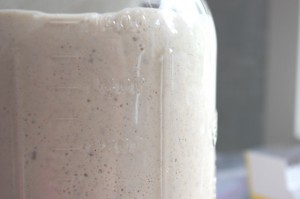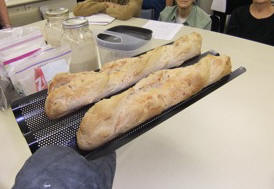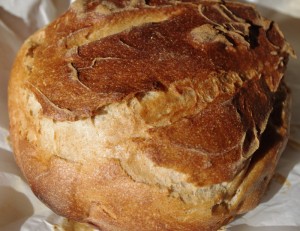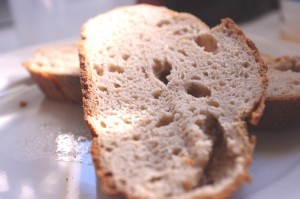As you know, I`ve been playing around here with Dr. Jean Layton`s gluten-free sourdough flour blend, creating a starter with honest-to-goodness Vancouver Island wild yeast — it`s been a fun few months of mucking around creating various starters, finding Dr. Jean`s flour blend, and then exploring the many things you can do with it!
I was also invited to attend the most recent Victoria Chapter meeting of the Canadian Celiac Association to do a bread baking demo, where we walked through using the wild yeast starter for sourdough baguettes. When you combine the use of the wild yeast starter, with basic ratios, and opt to weigh your ingredients, the baking is actually much more intuitive than conventional gluten-free bread baking, and is quite a bit more forgiving in terms of temperature variations, rise times etc. Here`s 2 baguettes fresh from the oven, where we were`t quite sure how well calibrated the oven was, and had to cut the rise time short!
As I noted in the last post, Dr. Jean Layton has also been working on her sourdough recipe, and just posted hers today on her recipes blog. It`s always interesting to see what different approaches different gluten-free bakers opt to take — she has achieved a fabulous result with a lower hydration level (somewhere closer to the typical 67% hydration level you would get with a 1-2-3 sourdough formula).
When I was playing around with the sourdough starter, I opted for a higher hydration level, which allows you a shorter rise time (good if you`re in a hurry) because the dough is considerably softer, but I also started with a smaller amount of starter.
So here you go: This recipe makes both baguettes and boules. If you opt to make 1 large boule, you can cut the liquid down by about 1/4 cup. Mound the dough onto a piece of parchment, smooth into a round boule shape and let rise until nearly double in size. While the boule is rising, preheat the oven AND a lidded cast-iron dutch oven to 450 degrees. Slash the dough before baking, plop the dough on the parchment into the hot pan, cover with the lid and bake in the oven at 450 degrees for 25 minutes. Remove the lid, reduce the oven to 400 degrees and cook for another 30-35 minutes, until the internal temperature reaches 205 degrees.
Gluten-free Wild Yeast baguettes (Printer friendly recipe)
1-2 hours before you plan to bake, remove the “mother” starter from the fridge, mix together your “starter” for the recipe …
- 1/2 cup sourdough starter
- 1/2 cup water
- 1 Tablespoon potato flour (NOT starch)
Let sit, covered for 1 –2 hours to get the wild yeast going again.
In a medium bowl, combine dry ingredients and whisk well
- All of the starter you made earlier
- 1 Tablespoon honey
- 1 Tablespoon neutral flavoured oil
- 1 1/2— 1 3/4 cup water
Add the dry ingredients to the mixer, and mix at medium speed for at least 3 minutes until the dough becomes smooth
- 200 grams Jean’s sourdough flour*
- 50 grams cornstarch
- 50 grams tapioca starch
- 2 1/4 teaspoons xantham gum (or guar gum)
The dough will be very soft and billowy, and should be wet enough to allow it to rise easily. If it looks like it needs more water, add 1-2 T at a time.
Use a scoop to place the dough in a greased baguette pan. Smooth out the baguettes and slash. Let sit, covered for at least 1 hour, and up to 4 hours. You can also raise the baguettes overnight in the fridge for further development of the flavours.
20 minutes before baking, preheat oven to 425 degrees.
Bake for 30-35 minutes
* Sourdough flour blend (makes 1 large batch of flour, weight, 145 grams per cup)
- 583 grams brown rice flour
- 583 grams sorghum flour
- 583 grams millet flour
- 290 sweet rice flour
- 74 grams garfava flour
- 155 grams white bean flour (I switched the proportions of the garfava/white bean flours)
To make a starter: Mix at 100% hydration (equal parts water and flour), let sit 2 days at room temp until it starts to bubble.
After 2 days, you can start to feed the starter — approximately 1/4 the volume of the total starter. (e.g. if the starter is 2 cups, feed it with 1/4 cup flour + 1/4 cup water. Every 3rd feed or so, adding 1T potato flour will help promote active yeast growth in the starter.
If you keep the starter in the fridge, feed it approximately 1 x per week, or every time you take it out to bake. The starter can be used for breads, but can also be used to leaven other things from muffins to pancakes — just bear in mind that your final product will have the “tang” of the wild yeast starter.
As always, if it has yeast in it, we send it over to Yeastspotting, that bloggy repository of all things yeasty and baked! If you haven`t checked it out, its very inspiring to check out the amazing baking!
4 Responses to Gluten-free Wild Yeast Baguette and Boule
Leave a Reply Cancel reply
My latest Tweets
- A bit windy here by the water in #yyj. Hope @peridotartcards and I don't get blown away on our weekly walkies!
- RT @tradertiki: loves you. That's why I'm offering 20% off of orders over $30, just enter code ILOVETIKI at checkout at http://www.trade ...
- @joshua_uu what about @jeremy_baker ?
- @doomcat87 Tales ... http://www.talesofthecocktail.com/info/totc_vancouver_2011
- @eshun thanks for letting me know how it went! glad u liked it :)


















This looks amazing, your baguetts have that fragile quality of a crispy crust that might shatter in a good breeze.
I will have to try these out soon. So glad you enjoy the flour mix.
[...] Gluten-Free Wild Yeast Baguette and Boule [...]
Super interesting post and nice GF bread.
And what a sweet surprise to read mention of my 1.2.3 sourdough formula
I’ll mention your post, with a link, on today’s Weekly Bread on VotrePain.com.
Have a nice day
Flo Makanai
Hi, I’m still making your baguettes recipe with my tweaks (omit the flax, decrease the liquid, sub millet for amaranth) at least weekly, usually on Sunday because that’s when I have the free time, and I am getting consistently stellar loaves. I especially love them with sesame seeds on the top. The only problem is that they disappear too quickly! I discovered a fun thing by accident: baking the bread while roasting tomatoes (same temp works for both) is a great way to get moisture in the oven!
I have mixed feelings about trying another bread recipe because the baguettes are so good, why mess with success, but I will try this one soon. Who knows, it could become my next go-to bread!
Thanks for all of the work you’re doing in developing these gluten free bread recipes. When I got diagnosed 10 years ago, I couldn’t have imagined ever eating such good bread. I gave up, quickly, on commercial GF breads. I used Bette Hagman’s recipes to make my own, and they were OK, and I deeply appreciate her pioneering use of flours other than rice flour, but things have progressed a long way. I’m sure she would be happy to see the changes.
Again, thanks.
Mary